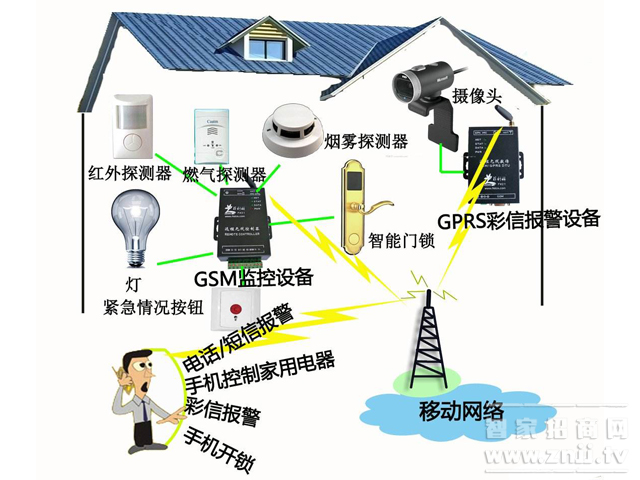With the continuous development of network technology and communication technology and the continuous improvement of people's living requirements, it has become an inevitable trend to achieve remote control of home intelligence. The National Center for Housing Industrialization Promotion of the Ministry of Construction has proposed six intelligent requirements for residential communities, including the implementation of automatic security monitoring and management: automatic alarms for fires and harmful gas leaks in residential buildings; infrared alarms or microwaves should be installed in the anti-theft alarm system. Various types of alarm detectors; systems should be able to network with computer security integrated management systems; computer systems can centralize management and control of burglar alarm systems. However, due to the current immature wireless communication technology, high operating costs, smart home controller and external network wireless communication technology has become an important factor leading to low market acceptance, and the characteristics of the GPRS system can be a good solution to this problem. The GPRS network communication service is a data transmission communication service launched by the communication company. Within the coverage area of ​​the GPRS network, the transmission distance is not limited, the communication cost is relatively low, and the transmission rate is relatively fast. This article relates to the background of home intelligence system and GPRS technology, analyzes their basic characteristics and the basic functions to be achieved. Based on this, it proposes an overall solution based on GPRS wireless smart home system. Finally, the method of hardware and software implementation of the system core GPRS chip is summarized.

Overall system architecture
The popularization of network applications and the production of various information appliances all make access to the Internet within the home no longer confined to a single PC. Each home will face how to transmit Internet data within the home and how to connect various home appliances. The problem, based on this, emerged as a smart home network. The smart home network is the basic unit of the information society. In the future home, various home appliances will form a home LAN and access the Internet through the smart home controller. The market potential of the smart home network is extremely promising. Several large companies such as Intel, IBM, Microsoft, and Sony have long been involved.
Smart home network refers to establishing a communication network in a home, connecting various home appliances to each other, realizing the remote use and control of home appliances on all smart home networks and any required information exchange, such as music and television. Or data, etc. The architecture of the smart home network includes home network systems, smart home controllers, and data communication between the smart home network and the external Internet network. Among them, the smart home controller is an important part of the smart home network, and plays a key role in management, control, and external network communication. It is a system that integrates various subsystems related to home life through the home management platform. It is also a physical interface that connects home intelligence with internal and external networks. It also performs data exchange between home internal and external communication networks. It is also responsible for Home equipment management and control.
On the one hand, the smart home controller needs to provide a communication interface for the internal wiring of the home, can collect information of the home device, and perform processing, automatic control and adjustment; on the other hand, the smart home controller serves as a home gateway and also provides a network interface for external communication. The home internal network and the external Internet network allow the user to access the home internal network through the network and other methods to achieve monitoring and control. In addition smart home controller should also have automatic alarm and other functions, that is, when the alarm signal is found such as: someone maliciously intrudes, the temperature is too high, the controller can immediately handle and send an alarm signal to the user.
The smart home controller is the core of the system and can be designed with ARM embedded system. It can automatically run and process data and manage and control each control terminal through the RS485 bus. And the controller realizes the communication between the home system and the external network through the GPRS module, so that the user can realize remote control of the home system through short messages and the Internet. At the same time, the controller also provides the user with a human-machine interface through the keyboard and the display screen. Users implement local control. The control terminal is composed of several small control systems for the single-chip microcomputer to control each household equipment, and these small control systems are networked through the control bus, connected to the smart home controller, and controlled by the smart home controller.
The smart home controller's specific features include:
Data collection of household equipment : Collecting the status data of household equipment including indoor temperature, lighting appliances, security doors, etc., is fed back to the user after processing by the controller.
Local control: The user monitors the home device through the keyboard and display on the controller.
Remote control: Remote users can control and query home systems by sending SMS messages or via the Internet.
Automatic alarm: When the controller detects an illegal incoming or over temperature alarm signal, the indoor alarm device is triggered in time, and the user is informed in a timely manner by sending an alarm message.
Temperature query: Users can query the room temperature through the controller.
Anti-theft door password setting: Users can modify the security door's password locally or remotely and open the door after entering the correct password outside the door.
Infrared home appliance control: receiving user commands, through the infrared emission control circuit television, air conditioning, infrared controllable home appliances.
Other light switches and other switch control: receiving user commands to control lighting and other switch equipment.
The smart home controller realizes the communication between the home system and the external network through the GPRS module, which is the core part of the system, and solves the key technology of the bottleneck of the previous smart home system. The abbreviation of GPRS (General Packet Radio Service) is a new packet data bearer service developed by adding new GGSN (gateway support node) and SGSN (service support node) nodes to the existing GSM system. The fundamental difference between GPRS and the existing GSM system is that GPRS is a packet switching system, which is particularly suitable for intermittent, sudden or frequent, small amounts of data transmission, and also for occasional large data transmissions. The main advantages of GPRS network transmission are: always online, traffic accounting, fast login, high-speed transmission, unlimited coverage (transmission distance, terrain, weather, etc.), reliable data transmission, etc.
Hardware and Software Implementation of Smart Home Controller Based on ARM and GPRS
The GPRS communication module is installed in the smart home controller. The main function is to connect to the Internet through the GPRS network and actively establish a communication link with the monitoring center for two-way data communication. The GPRS communication module design adopts the G24 GPRS OEM built-in TCP/IP protocol built by Freescale. The module is small in size, low power consumption and easy to integrate.
The GPRS communication terminal transceiver module is mainly composed of a G24 module, an antenna, a SIM card, an associated level conversion circuit, and an RS232 serial port. The module's supply voltage is 5V and it can be powered by a USB port. The GPRS communication module communicates with the smart home controller ARM through the RS232 serial port.
The G24 transceiver module operates using the AT command and communicates data via the RS232 serial port. The GPRS network communication principle is: First, the communication terminal module is attached to the GPRS network through the SGSN node; then a randomly assigned IP address is obtained by the PPP (PointtoPoint Protocol) protocol through the GGSN node, and is connected to the Internet; finally, the communication terminal module passes through the Internet, Set up a communication link with the monitoring center according to the port number set by the monitoring center.
(1) Test whether the G24 communication is normal. First select the serial port and set the baud rate. The G24 baud rate is in the range of 600 to 460800 bit/s. It supports automatic baud rate listening and can automatically match the baud rate of the monitoring center's communication module. Send "AT", if the module returns "OK", the communication is normal, otherwise retransmission.
(2) access to the Internet. First test whether there is GPRS coverage in the local area and send “AT+CGPRS?†to the module. If “+CGPRS:1†is returned, there will be GPRS coverage, otherwise it will be detected again after 5 seconds. Then send "AT+CGATT=1" to attach the module to the GPRS network. Finally, “AT+MIPCALL=1,cmnet†is sent to establish a wireless connection with the GGSN through the PPP protocol to obtain a dynamic IP address and access the Internet.
(3) Connect to the monitoring center. Send the module "AT+MIPOPEN=,,
SocketID: G24 communication connection ID number, G24 has 4 available Sockets, each Socket has 1372Byte buffer.
SourcePort: G24 data transmission port number, which is 0~65535. It is recommended to use a port number of 1024 or higher.
DestinationAddress: The IP address of the target, which is the IP address of the monitoring center monitoring server.
DestinationPort: The number of the data transmission port on the target side, that is, the transmission port number set by the monitoring center monitoring server.
Protocol: Transport protocol. 0 means TCP and 1 means UDP.
(4) data transceiver. After establishing a communication connection with the monitoring center, data can be sent and received. Send data with "AT+MIPSEND=1, 'Data';+MIPPUSH=1". "Data" indicates the data to be sent. This design adopts the G24 default ASCII code and must be expressed in hexadecimal ASCII code. Once data arrives, the G24 module will return "+MIPRTCP:,," via the RS232 serial port. Among them, Left is a decimal number, indicating how many characters are still not received in the protocol stack. If the data is all received, Left is 0; the received data “Data†is in hexadecimal ASCII code form.
(5) Disconnect the communication. Send “AT+MIPCLOSE=SocketID†to the module, and the module returns “OKâ€, indicating successful disconnection.
Conclusion
This article proposes a total solution based on GPRS wireless smart home system. The program is mainly to use GPRS wireless communication technology to achieve remote terminal remote control of the home system; use RS485 bus technology to achieve home networking; use embedded system program to build a smart home controller development platform, and through the platform to achieve Intelligent management and control of home appliances. Finally, this paper provides the hardware and software implementation methods of the system core GPRS chip, and provides the technical basis for follow-up and related work.
Window slice is a parallel plane plate, which is usually used as a protective window for electronic sensors or detectors in the external environment. The window slice does not change the magnification of the system. The base materials include various optical glass, K9, UV fused quartz, infrared fused quartz, calcium fluoride (CaF2), magnesium fluoride (MgF2), zinc selenide (ZnSe), germanium (GE), silicon (SI) and other crystal materials, and provide various optical coatings such as antireflection film, high reflection film, spectroscopic film and metal film. Broadband antireflective films can be used in ultraviolet, visible, near-infrared and mid infrared bands.

Optical Windows,Optical Round Corner Windows,Circle Window,Wedge Window
Hanzhong Hengpu Photoelectric Technology Co.,Ltd , https://www.hplenses.com
